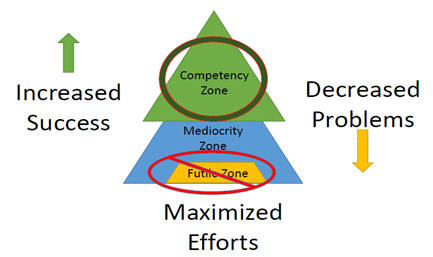The 80/20 Rule: The 3 Zones of Competency:
- joel
- Dec 18, 2023
- 3 min read
Core Competencies: The Top 20%:
The Pareto Principle is valuable to understand because when we look at the world through our natural lenses, we want to see it as being flat and fair. We want to think that as long as we sow hard, we will reap hard, and as long as we keep busy, we won’t have any effort go unnoticed or unrewarded. We think that everyone who works hard should be equally rewarded for their efforts. The mediocre leaders will never be rewarded equally to the exceptional leaders.
That would be great if it were so, but the truth is that very few of the efforts we make move the success needle as much as we tend to think. We have all likely experienced some success in our lives that stems from great ideas, hard work, or creative thought. These successful endeavors likely came about through just a handful of talents, habits, or skills that you possess.
You have heard the phrase, "Work smarter, not harder." Working smarter is always a great strategy, and part of this strategy is maximizing the time and efforts spent on the efforts that yield the best return (top 20%) for our investment (ROI). We like to think that we are decent at a lot of different things. We can do many things well and have a broad understanding of the world. That is rubbish. The truth is that most of us are only truly exceptional at three to five things. That’s it. We do many more things outside of these three to five things, but most of our success can be attributed to the time and efforts that come from these key areas of strength. These are your core competencies that yield most of your results. They are your top 20%. You should pay very close attention to these core competencies and put a hedge around them to make sure they are not squeezed out of your life or schedule by your lesser skills and efforts.
"The truth is that we are all only really good at three to five things. That’s it"
Some people go through their entire lives without establishing a good understanding of their core competencies. The success we have had we attribute to our collective knowledge and all the different skills we have picked up over the years. We take great pride in being well rounded. We know we are better at some things, but what we don’t realize is how many things we think we are decent at that don’t add any real value to the overall project, not to mention sometimes even taking away from the success of the project without even knowing it.
When we can learn to focus intently on our core competencies more often with fewer distractions, we maximize our time spent in "the zone". A more modern term being used these days is "flow state". When we are in the zone or in a state of flow, our output of production, creativity, and influence soars past all other outputs when exercising outside of this state.
Until we fully understand our core competencies and leverage them, we will continue to be on the wrong end of the Pareto Principle.
The 3 Zones of Competency:
· Competency Zone: The time, efforts, and skills used that contribute to most of your successful results from using your unique gifts and core competencies. These are the 20% of your efforts that lead to 80% of your results.
· Mediocrity Zone: The time, efforts, and skills we often believe contribute to success but really add very little, if any, value to the project. These are the efforts we make that keep us afloat at best. They are often necessary but should never be counted on to bring home the gold medal. These are the 60% of your efforts that contribute some to the solutions (20%) and some to the problem (20%).
· Futile Zone: The time you waste when you should be doing more important things, the efforts you make in vain, and the skills you pretend you have that only make things worse. These are the 20% of your efforts that lead to 80% of your problems. Stop it!
Where do you spend your time?
Joel Smith
Business Coach, Author and Entrepreneur
This article is a section out of the book Team Design: Building Great Teams By Attracting the Right People. Download the Free PDF version.








Comments